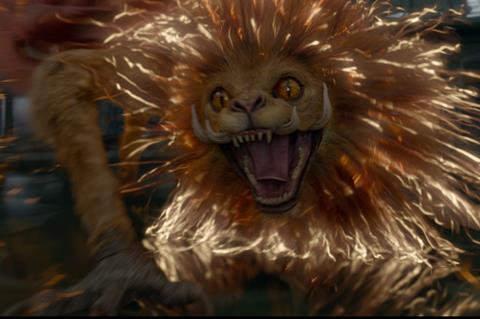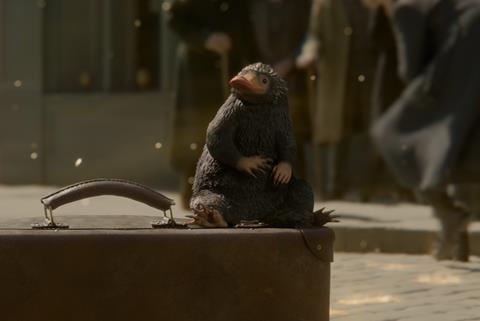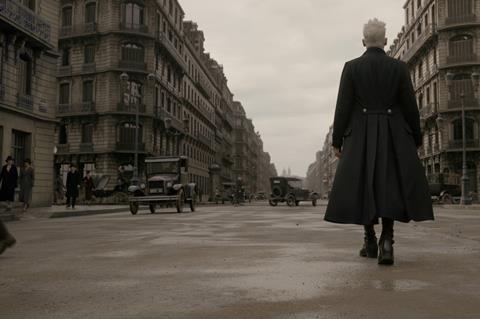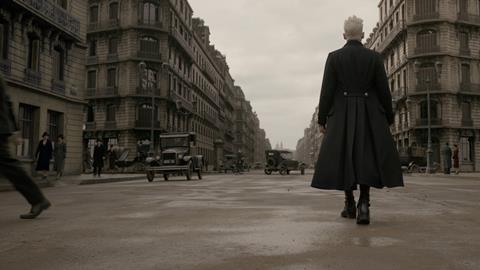With around half of Fantastic Beasts: The Crimes of Grindelwald’s $200m budget comprising VFX shots, Framestore Creative Director Christian Manz reveals the VFX story to IBC365, detailing work on key scenes, the re-invention of Paris and the creation of some of the more fantastic of the beasts.
Warner Bros has kept under wraps any word about the making of Fantastic Beasts: The Crimes of Grindelwald until two weeks into the movie’s release. The film is the second in a slated series of five and marks the tenth film in the Wizarding World franchise, which includes the eight Harry Potter movies. For the Fantastic Beasts sequel, the setting has moved from New York to Paris.

Director David Yates was reunited for the sequel with joint overall VFX supervisors Tim Burke and Framestore Creative Director Christian Manz who worked together on the first of the series, Fantastic Beasts and Where To Find Them, released in 2016. The VFX brief from Yates was to keep the magical world as real as possible.
Burke and Manz came on board in January 2017, reading initial scripts. Having directed the pre-vis and creature design together, the work was split between them, largely aligning so that they each worked with one set of vendors, as well as mixing it up a bit from the last film. Where Burke worked on the obscurus (the manifestation of the repressed energy of a magical child) last time, Manz took it on; where Manz did the magic suitcase before, Burke took his turn.
Throughout the core production process a close team of 50 looked after the VFX, but the overall VFX workforce numbered closer to 1,400.
After the shoot, based in the UK at Warner Bros Leavesden Studios from July to the end of 2017, around 2500 shots went into post vis. By the end of March 2018, the director’s cut included closer to 1450 shots. It was this version that was turned over to the vendors to build the VFX assets.
The opening sequence sees the anti-hero Grindelwald, played by Johnny Depp, being moved from prison in New York in a flying carriage drawn by winged horse-like thestrals. “I liken it to a James Bond opening sequence,” says Manz. “David’s brief wanted it to feel real, like you were flying.
“We wanted it to be very gothic, with lightning and pelting rain. It was dark, so I was keen for it to be black, unless lit up by lightning or streetlights…There were a lot of moving parts and it had to make sense. It was a real collaboration between myself, production designer Stuart Craig, art director Martin Foley, stunt co-ordinator Eunice Huthart, David Yates, the second unit director and the actors.”

Huthart came up with a ‘tuning fork’ rig so that the broom outriders could actually sit on brooms, making the performances “a lot more fluid and real.” Costume designer Colleen Atwood introduced long cloaks and goggles, which helped with CG faces. The whole sequence was shot using a real carriage, which was ultimately replaced with a full CG version.
After various tests to get the squally weather just right, the actors were hosed down and wind blown at them, with falling rain added later. At one point the carriage magically fills with water.
“In the end we did ‘dry for wet’. We used gels and filters to cross polarise the lighting, which means that you lose all of the highlights and reflections on the actors and set, replicating what happens under water. We blew air and filmed it at double speed which made them feel more weightless.” Image Engine, which built the scene in CG, added diffusion, blur and bubbles.
VFX created by:
Framestore
DNEG
Rodeo FX
Image Engine
Deluxe Method Studios
Milk
Lola
Previs and postvis:
The Third Floor
Proof Inc
NVisage
In the same sequence, there are close-up transformations where one character turns into another. “My brief to the team was to imagine what would happen if this was real. Rather than just being a morph, your bones would be moving around and it would be quite painful.”
With the movie drawing strongly on the Harry Potter universe, the production team raided the Warner Bros archive and Harry Potter Tour for a number of set elements and references. For one shot, Yates was after the Great Hall with floating candles: Manz went with scanning vendor Clear Angle for an after-hour’s visit to the original set of the Great Hall - in situ at the Leavesden Harry Potter Tour.
There are echoes of Harry Potter throughout the film. “Our job is to make it look as good as we can for now, respecting what was done before, but updating it.”

For the Ministry of Magic in London, “you get a sense of the height and scale of the atrium when you fly down with the owls to find Newt Scamander [played by Eddie Redmayne] near the beginning of the film. You’re able to show the audience a new look on something familiar.”
With most of the action set in Paris, the French capital was recreated on the back-lot set at Leavesden. But, unlike New York in the 1920s, much of Paris hasn’t changed over the last 100 years. “We went to Paris to do recces and take photographs so that we could incorporate real Paris into the set. We had a shopping list of places that needed scanning and had a team in Paris for a month. We scanned 90 locations - whole streets, entire buildings, including the Sacre Coeur - ending up with a kit of parts to create our digital environments. For post vis, the scans were laid out and matte painted into shots to check with Stuart that the look was correct, before getting Framestore and Rodeo FX to build the final environments.”
One scene is set in a roof-top attic space, where the mysterious wizard Credence turns into an obscurus and the roof explodes, with the wrecked material from the explosion fired back at Ministry assassin Grimmson. Again, a full set was built and then the actors were put up against green screen in a partial set. “Rodeo built it - from the tiles and the batons underneath, layering it exactly as it would be for real, so that when it exploded the simulation was accurate.”
London was deep in fog for a scene with Newt and Dumbledore, (played by Jude Law.) Cinematographer Philippe Rousselot provided photographic references of fog for shape and light. As with other shots through the production, Burke and Manz insisted on shots being captured at the right time of day in order to get the right digital look and feel. “David backed us up on this, because you needed the real light to make you believe you were really there.”
There were around 50 creatures in the script, most of them new ideas that needed designing. Burke and Manz put their heads together, did some googling and created an original guide to each creature to give to concept artists, incorporating detail from the script. Some creatures, including the kelpie, are based on mythology. In this way, 1000 pieces of concept artwork were drawn up in the early stages, with Framestore and ILM’s art departments freelance artists such as Rob Bliss and Paul Catlin.
Framestore’s Pablo Grillo, animation director on the first Fantastic Beasts, was busy on Paddington 2, so animation supervisor Nathan McConnel headed up creature creation. “David really likes to work with an image that shows the character and look, so we had a small team, taking some concepts through, initially discovering by building simple models…We wanted to workshop them so that by the time you’re shooting, you’ve got something that you can show the actors – Eddie and the gang – what it looks like and how it’s going to behave. Then you can build puppets to help their performances.”
One of the starring creatures in the new film is a Chinese dragon called a zouwu that features in several scenes. “We were keen to make it something quite unique, so we were looking at a lot of Chinese artwork and reading up a bit on Chinese mythology.” Manz describes how the final zouwu was an idea originally rejected “because it was so bonkers”, but one of the animators, in his first week on the job, remodelled it in a way that caught Yates’ imagination.
Some of the creatures, including large snail-like animals called streelers, were based on designs that didn’t make it through for the last film. But they had to reach a high bar. Writer and producer J. K. Rowling was hands-on with the production, at one point visiting the animation studios. One design, for a multi-headed dog, was too similar to Hagrid’s Fluffy in The Philosopher’s Stone.
“It’s lovely for the team, but you’re really nervous because you’re playing in her universe.”
- Read more Fine-tuning Bohemian Rhapsody

























No comments yet